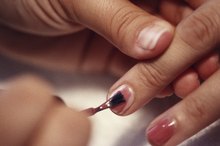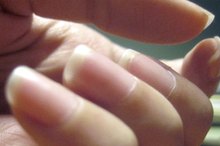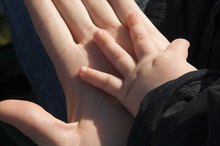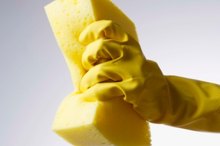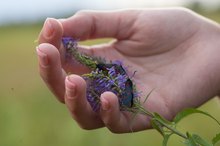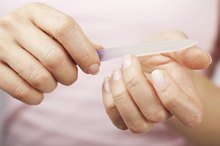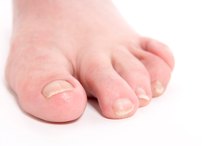What does fact checked mean?
At Healthfully, we strive to deliver objective content that is accurate and up-to-date. Our team periodically reviews articles in order to ensure content quality. The sources cited below consist of evidence from peer-reviewed journals, prominent medical organizations, academic associations, and government data.
- Medline Plus: Hypothyroidism
- MayoClinic.com: Iron Deficiency Anemia
- Clinics in Podiatric Medicine and Surgery: Nail Dystrophies
- Clinics in Podiatric Medicine and Surgery: Nail Dystrophies
- Centers for Disease Control and Prevention: Fungal Nail Infections
- Journal of Dermatological Treatment: Biotin for the Treatment of Nail Disease: What Is the Evidence?
- Journal of Dermatological Treatment: Biotin for the Treatment of Nail Disease: What Is the Evidence?
The information contained on this site is for informational purposes only, and should not be used as a substitute for the advice of a professional health care provider. Please check with the appropriate physician regarding health questions and concerns. Although we strive to deliver accurate and up-to-date information, no guarantee to that effect is made.
What Are the Causes of Splitting and Peeling Nails?
- How Moisture Affects Splitting and Peeling Nails
- Can Nail Trauma Lead to Splitting and Peeling Nails?
- Can Everyday Chemicals Damage My Nails?
- Can Nail Infections Cause Splitting and Peeling?
- Which Medical Disorders Can Split and Peel Nails?
- Can Nutrient Deficiencies Affect My Nails?
- When to See a Doctor for Splitting and Peeling Nails
**About 20 percent of the population has brittle nails, characterized by nails that split or peel into layers, according to a June 2018 review article in “Journal of Dermatological Treatment.**” Also known as onychoschizia, splitting and peeling nails tend to become more common with age.
Splitting and peeling nails are most often due to too little or too much moisture in the nails, trauma to the nails or a fungal nail infection. These causes tend to affect just one or some of the nails.
Various vitamin deficiencies and medical disorders can also produce splitting and peeling nails. Because they begin as an internal problem, these causes are more likely to affect most or all of the fingernails and toenails.
How Moisture Affects Splitting and Peeling Nails
Most instances of splitting and peeling nails are caused by lack of moisture, according to the American Osteopathic College of Dermatology (AOCD). Repeatedly wetting and drying the hands — and therefore fingernails — can cause the nails to become dried out and brittle.
Hand sanitizers
Less commonly, fingernails can be too moist. This produces soft nails that are also prone to peeling 8.
Fingernails can be protected from becoming wet by wearing gloves for activities in which the hands are immersed in water, such as washing dishes.
AOCD recommends applying a moisturizing lotion containing alpha-hydroxy acids or lanolin to help prevent or treat dry and brittle nails. Limiting the use of alcohol-based hand sanitizers may also be helpful.
- Most instances of splitting and peeling nails are caused by lack of moisture, according to the American Osteopathic College of Dermatology (AOCD).
- Fingernails can be protected from becoming wet by wearing gloves for activities in which the hands are immersed in water, such as washing dishes.
Can Nail Trauma Lead to Splitting and Peeling Nails?
Why Do My Fingernails Peel & Break?
Learn More
Injuries to the nails can cause splitting and peeling. Nail biting leaves fingernails ragged and prone to additional damage. Using the fingernails as tools for scraping and prying will also cause nail injuries.
Typing produces repeated trauma to the nails, especially when they are long. Nails can also be damaged during grooming activities, such as using metal instruments to push back cuticles.
Keeping nails trimmed short and filing them with an emery board into a rounded shape may help reduce splitting and peeling. Short nails can also reduce nail trauma while typing.
Avoiding the use of nails as tools and being gentle when performing grooming activities are other useful strategies.
Applying a coat of clear nail polish once a week may help protect nails from injury, according to AOCD. Polishes containing nylon fibers are preferred, as they may also strengthen the nails.
- Injuries to the nails can cause splitting and peeling.
- Keeping nails trimmed short and filing them with an emery board into a rounded shape may help reduce splitting and peeling.
Can Everyday Chemicals Damage My Nails?
Household cleaning fluids or detergents may dry out or directly damage the surface of nails, leading to peeling and splitting.
Colored nail polish, adhesives used for glue-on nails and nail polish removers may also cause nail damage. Removers containing acetone
The effects of chemicals on nails can be reduced or eliminated by limiting exposure to the chemicals. Wearing rubber gloves during household cleaning activities will help protect fingernails. Adding a moisturizer to the nails after each chemical contact may also be useful.
- Household cleaning fluids or detergents may dry out or directly damage the surface of nails, leading to peeling and splitting.
- Adding a moisturizer to the nails after each chemical contact may also be useful.
Can Nail Infections Cause Splitting and Peeling?
Weak Fingernails
Learn More
Fungal infections of the nails frequently cause splitting and peeling 6.
They are more common in the toenails than fingernails and usually affect one to a few nails at the same time. The nails become thicker but more brittle.
Fungal nail infections are often recognized by the typical color changes they produce, causing the nail to become yellowish or light brown.
Fungal infections are more likely to occur in nails that have been injured and in people with diabetes, poor circulation in their feet or a weakened immune system, according to the Centers for Disease Control and Prevention (CDC) 6.
As fungi grow best in moist environments, walking barefoot in locker rooms or public shower areas increases the likelihood of getting a fungal infection. Several over-the-counter medications are available to treat fungal nail infections, but prescription medications are sometimes needed.
- Fungal infections of the nails frequently cause splitting and peeling 6.
- Fungal nail infections are often recognized by the typical color changes they produce, causing the nail to become yellowish or light brown.
Which Medical Disorders Can Split and Peel Nails?
A number of medical disorders may cause peeling and splitting nails. One of the most common is hypothyroidism — an underactive thyroid gland, which causes the nails to become thin and dry 2.
Other possibilities are blood vessel disorders affecting the feet or hands, psoriasis, diabetes, sarcoidosis and Sjorgren syndrome. All of these conditions produce other symptoms as well.
Chemotherapy medications and certain pills used to treat acne may also cause peeling and splitting nails.
- A number of medical disorders may cause peeling and splitting nails.
- Chemotherapy medications and certain pills used to treat acne may also cause peeling and splitting nails.
Can Nutrient Deficiencies Affect My Nails?
Iron deficiency can produce brittle nails 3. Nail changes usually do not occur until iron deficiency is severe enough to also cause anemia — low numbers of red blood cells in the body 3.
Iron deficiency anemia may produce various symptoms, including pale skin, headaches and pica — an unusual craving for non-nutritive substances, such as ice or dirt 3. Iron-rich food or iron supplements will reverse the deficiency.
Biotin deficiency may also cause brittle nails that peel and split. True biotin deficiency is rare, however, because biotin is found in a large number of foods and the body needs only a small amount of biotin.
But even in people with normal biotin levels, biotin supplements may help brittle nails. Current research suggests that daily biotin supplements improve hardness, thickness and firmness of brittle nails, according to a June 2018 review article in “Journal of Dermatological Treatment. 11”
- Iron-rich food or iron supplements will reverse the deficiency.
- But even in people with normal biotin levels, biotin supplements may help brittle nails.
When to See a Doctor for Splitting and Peeling Nails
If you have brittle nails, see your doctor to help determine the cause and begin appropriate treatment. As the cause is often related to moisture or trauma, simple measures may be all that are needed.
But if you have a fungal infection, your doctor will likely recommend an antifungal medicine. Your doctor can also determine whether your nail problems are a sign of a medical disorder or nutrient deficiency.
Reviewed and revised by Mary D. Daley, M.D.
- If you have brittle nails, see your doctor to help determine the cause and begin appropriate treatment.
- Your doctor can also determine whether your nail problems are a sign of a medical disorder or nutrient deficiency.
Related Articles
References
- Skinsight: Nail Splitting (Onychoschizia)
- Medline Plus: Hypothyroidism
- MayoClinic.com: Iron Deficiency Anemia
- Clinics in Podiatric Medicine and Surgery: Nail Dystrophies
- Doctors Health Press: Splitting Nails (Onychoschizia): Causes and Treatment Tips
- Centers for Disease Control and Prevention: Fungal Nail Infections
- University of Pennsylvania Medical Center: What Causes Brittle Nails? How You Can Treat Weak Fingernails
- Canadian Dermatology Association: Brittle Nails
- Journal of the American Academy of Dermatologists: Brittle Nail Syndrome -- A Pathogenesis-Based Approach With a Proposed Grading System
- Carter Snell Skin Center: What Do Your Brittle Nails Say About Your Health?
- Journal of Dermatological Treatment: Biotin for the Treatment of Nail Disease: What Is the Evidence?
- Singal A, Arora R. Nail as a window of systemic diseases. Indian Dermatol Online J. 2015;6(2):67-74. doi:10.4103/2229-5178.153002
- Yaemsiri S, Hou N, Slining MM, He K. Growth rate of human fingernails and toenails in healthy American young adults. J Eur Acad Dermatol Venereol. 2010;24(4):420-3. doi:10.1111/j.1468-3083.2009.03426.x
- Schons KR, Knob CF, Murussi N, Beber AA, Neumaier W, Monticielo OA. Nail psoriasis: a review of the literature. An Bras Dermatol. 2014;89(2):312-7. doi:10.1590/abd1806-4841.20142633
- Abdullah L, Abbas O. Common nail changes and disorders in older people: Diagnosis and management. Can Fam Physician. 2011;57(2):173-81.
- Sarkar M, Mahesh DM, Madabhavi I. Digital clubbing. Lung India. 2012;29(4):354-62. doi:10.4103/0970-2113.102824
- Haneke E. Controversies in the treatment of ingrown nails. Dermatol Res Pract. 2012;2012:783924. doi:10.1155/2012/783924
- Jefferson J, Rich P. Melanonychia. Dermatol Res Pract. 2012;2012:952186. doi:10.1155/2012/952186
- Aging Changes in Hair and Nails. Medline. National Institutes of Health Public Information Sheet.
- Nails and Nail Problems. American Academy of Dermatology Public Information Sheet.
Writer Bio
Based in Houston, Texas, Dr. Mary D. Daley has been writing and editing health and medicine articles for more than 20 years. Daley holds an MD degree, as well as an MS in immunology and MS in biomedical writing. She is board-certified as an anesthesiologist in the United States and Canada.
